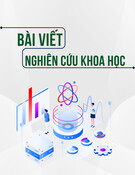Modelling and simulating interleukin-10 production and regulation by macrophages after stimulation with an immunomodulator of parasitic nematodes Ana Sofia Figueiredo1, Thomas Ho¨ fer2, Christian Klotz3, Christine Sers4, Susanne Hartmann3, Richard Lucius3 and Peter Hammerstein1
1 Institute for Theoretical Biology, Humboldt University, Berlin, Germany 2 Research Group Modeling of Biological Systems, German Cancer Research Center and BioQuant Center, Heidelberg, Germany 3 Department of Parasitology, Berlin, Germany 4 Institute of Pathology, Universitaetsmedezin Charite´ , Berlin, Germany
Keywords autocrine crosstalk; host–parasite interaction; regulation; signalling cascades; systems biology
Correspondence A. S. Figueiredo, Institute for Theoretical Biology, Humboldt University, Invalidenstrasse 43, 10115 Berlin, Germany Fax: +49 30 20938801 Tel: +49 30 20938450 E-mail: s.figueiredo@biologie.hu-berlin.de
to sustained when the concentration of
Note The mathematical models described here have been submitted to the Online Cellular Systems Modelling Database and can be accessed at http://jjj.biochem.sun.ac.za/ database/figueiredo1/index.html, http://jjj. biochem.sun.ac.za/database/figueiredo2/ index.html, http://jjj.biochem.sun.ac.za/ database/figueiredo3/index.html and http:// jjj.biochem.sun.ac.za/database/figueiredo4/ index.html free of charge
(Received 5 September 2008, revised 22 February 2009, accepted 21 April 2009)
doi:10.1111/j.1742-4658.2009.07068.x
Parasitic nematodes can downregulate the immune response of their hosts through the induction of immunoregulatory cytokines such as interleukin- 10 (IL-10). To define the underlying mechanisms, we measured in vitro the production of IL-10 in macrophages in response to cystatin from Acantho- cheilonema viteae, an immunomodulatory protein of filarial nematodes, and developed mathematical models of IL-10 regulation. IL-10 expression requires stimulation of the mitogen-activated protein kinases extracellular signal-regulated kinase (ERK) and p38, and we propose that a negative feedback mechanism, acting at the signalling level, is responsible for tran- sient IL-10 production that can be followed by a sustained plateau. Specifi- cally, a model with negative feedback on the ERK pathway via secreted IL-10 accounts for the experimental data. Accordingly, the model predicts sustained phospho-p38 dynamics, whereas ERK activation changes from transient immunomodulatory protein of Acanthocheilonema viteae increases. We show that IL-10 can regulate its own production in an autocrine fashion, and that ERK and p38 control IL-10 amplitude, duration and steady state. We also show that p38 affects ERK via secreted IL-10 (autocrine crosstalk). These findings demonstrate how convergent signalling pathways may differentially control kinetic properties of the IL-10 signal.
Abbreviations AIC, Aikaike information criterion; AU, arbitrary units; Av17, cystatin from Acanthocheilonema viteae; ERK, extracellular signal-regulated kinase; H3, histone 3; IL-10, interleukin-10; IL-10e, extracellular interleukin-10; LPS, lipopolysaccharide; MAPK, mitogen-activated protein kinase; MKP, mitogen-activated protein kinase phosphatase; ODE, ordinary differential equation; rAV17, recombinant cystatin from Acanthocheilonema viteae; RSS, residual sum of squares; SP1, Sp1 transcription factor; STAT3, signal transducer and activator of transcription.
FEBS Journal 276 (2009) 3454–3469 ª 2009 The Authors Journal compilation ª 2009 FEBS
3454
In all of Parasitic nematodes are multicellular organisms occupy- ing diverse niches within their hosts. The economically and medically important nematodes reside in the intesti- nal tract, skin, muscles, blood or connective tissue of their hosts. these sites, nematodes are constantly exposed to various host immune responses.
A. S. Figueiredo et al.
Modelling interleukin-10 production and regulation
under normal conditions and are more prone to immu- nopathology in general, being able to clear infection by intracellular pathogens more effectively than wild-type mice [6,9]. This emphasizes the importance of IL-10 as an immune regulator.
(LPS)-stimulated or
Nevertheless, many parasitic nematode species live for years, a fact that has recently been explained by sophisti- cated immune evasion mechanisms deployed by the worms. For example, the species Onchocerca volvulus is the causative agent of the tropical disease river blindness (which afflicts about 20 million people worldwide), and can persist in its human host for more than 10 years. A rodents, Acanthocheilonema parasitic nematode of viteae, is used as an animal model to study basic ques- tions of host–parasite interaction, e.g. host immune responses and parasite immune evasion mechanisms. Parasitic nematode infections induce a Th2 response, which has the potential to trigger immune effector mechanisms that can efficiently kill parasitic worms. However, the presence of these worms seems to blunt this effect, and vigorous effector mechanisms do not develop. One way of interfering with immune effector mechanisms is to stimulate the production of anti- inflammatory cytokines such as interleukin-10 (IL-10). As a consequence, the ability of the host to kill the para- sites is compromised, and host pathology due to inflam- matory reactions is minimized. This balance allows survival of parasites and hosts. Blunted Th2 responses may represent a benefit for the host, as the ensuing downregulation of effector mechanisms decreases auto- immune responses and allergies [1,2].
e.g. mitogen-activated protein
The promoter region of the il-10 gene in macrophages contains binding sites for the transcription factors, e.g. Sp1 transcription factor (SP1) [10–12] and signal trans- ducer and activator of transcription (STAT3) [7,8], that regulate gene expression and are controlled by ERK and p38 [13]. In a sequential mechanism, the ERK signalling cascade remodels the chromatin of the il-10 promoter region by phosphorylating its histone 3 (H3) sites, and the p38 signalling pathway activates the tran- scription factors SP1 and STAT3 [7,8]. These transcrip- tion factors bind to the phosphorylated H3 sites and thereby initiate il-10 gene expression [7,8,14]. Macro- phages express the IL-10 receptor complex on their surface [15], suggesting feedback regulation by IL-10. A negative autoregulatory role for IL-10 is suggested for lipopolysaccharide lipoprotein- stimulated IL-10 production in monocytes and mono- cyte-derived macrophages [16–19]. On the basis of these findings, we assume that Av17 activates the ERK and p38 signalling pathways in macrophages, leading to IL-10 production, and we hypothesize that IL-10 is reg- ulated via a negative feedback mechanism of secreted IL-10 that binds to the macrophages and deactivates the ERK signalling pathway either by kinase inhibition or by phosphatase activation. Other ERK-induced molecules, kinase phosphatases (MKPs) can deactivate ERK and thereby regulate IL-10 induction (Fig. 1).
The search for molecules that modulate host immune responses has led to the identification of A. viteae cysta- tin (Av17), a filarial protein constantly secreted by the nematode [3] that inhibits cysteine proteases with impor- tant functions in immune processes such as antigen processing and presentation [4,5]. Furthermore, recom- binant Av17 (rAv17) has recently been shown to specifi- cally inhibit allergic and inflammatory responses in mice [6]. In this scenario, rAv17 induced macrophages to produce the anti-inflammatory cytokine IL-10 as a key element of immunomodulation. The fact that signalling through the extracellular signal-regulated kinase (ERK) and p38 mitogen-activated protein kinase (p38) induces IL-10 production in macrophages [7,8] has prompted us to model the respective signalling pathways.
The ERK and p38 signalling cascades are two exam- ples of MAPK cascades. They are central and highly conserved, and are present in many cell types. A myr- iad of stimuli can activate these kinases, which, in turn, activate many other transcription factors and regulators of transcription, controlling the expression of many genes. Although the mechanisms that control the different ERK activities are as yet unclear, diverse activation modes lead to diverging outcomes, despite the fact that the same cascade is in play [20–22].
[23] implemented mathematical models
FEBS Journal 276 (2009) 3454–3469 ª 2009 The Authors Journal compilation ª 2009 FEBS
3455
IL-10 is a cytokine with immunoregulatory proper- ties. It executes its functions on a wide range of cells, macrophages being a major source of this cytokine. One major function of IL-10 is to control and reduce excessive immune responses during infections and auto- immunity, mainly by inhibiting the production of pro- inflammatory cytokines in macrophages and other cell types. However, several studies show a regulatory role of IL-10 on T-helper cell responses of different types, e.g. Th1 responses, which can lead to autoimmune pathologies, and Th2 responses, which can lead to aller- gies. IL-10-deficient mice develop spontaneous colitis In order to better understand the complexity of MAPK signalling pathways, many mathematical mod- els of these cascades have been developed. Heinrich et al. for different topologies of the receptor-stimulated kinase ⁄ phosphatase signalling cascades and analysed key parameters that characterize the signalling pathways (signal amplitude, signalling time, and signal duration). Sasagawa et al. [24] constructed a mathematical model of ERK signalling based on literature findings and
A. S. Figueiredo et al.
Modelling interleukin-10 production and regulation
Fig. 1. A literature-based model of IL-10 induction and regulation by the helminthic immune modulator Av17. Av17 binds to the macrophage and activates the p38 signalling pathway (which will activate the transcription factors SP1 and STAT3) and the ERK signalling pathway (which will phosphorylate the H3 site of the il-10 promoter region). These transcription factors bind to this promoter site, inducing il-10 mRNA expression [14]. IL-10 protein is subsequently produced and secreted. We assume that extracellular IL-10 binds to the IL-10 receptor of macrophages and deactivates phospho-ERK, either by kinase inhibition or by phosphatase activation, hence regulating its own production in a negative feedback loop. IL-10 regulation can also occur through a redundant negative feedback loop: the ERK signalling pathway induces the expression of MKPs that can deactivate ERK.
http://jjj.biochem.sun.ac.za/database/figueiredo4/index. html free of charge. show that
Results
predicted ERK dynamics in response to increases in the growth factors epidermal growth factor and nerve growth factor. Both studies the same MAPK pathway can undergo a sustained or transient activation, as experimentally shown by Marshall [20] and Santos et al. [22]. The model
the experimental and literature On the basis of evidence described above, we developed mathematical models of IL-10 regulation on Av17 stimulation in macrophages. Model development was based on the principle of parsimony. In order to keep the number of parameters as small as possible, we included only those components and processes that we considered paramount to describe the systems dynamics and where data were available (see Fig. 2 for all compo- nents and reactions included in the models).
FEBS Journal 276 (2009) 3454–3469 ª 2009 The Authors Journal compilation ª 2009 FEBS
3456
We propose two different methods of regulation, via IL-10 (model 1 and model 2) or via an inhibitor (model 3), and compare them to a model with no feed- back (model 0). Model 1 assumes promotion of ERK dephosphorylation via IL-10 (kinase deactivation). Model 2 assumes inhibition of ERK phosphorylation via IL-10 (phosphatase activation). Model 3 assumes promotion of ERK dephosphorylation via an inhibitor (kinase deactivation). The components and reactions of these models are described in Table 1. The aim of this study was to develop mathematical models of IL-10 regulation on Av17 stimulation in macrophages in order to understand quantitatively whether the current qualitative knowledge of the mecha- nism is compatible with available data. Moreover, the feedback regulation of IL-10 in macrophages is not well understood at the moment. Therefore, we implement models distinguished by different types of regulation of IL-10 production to test how these different hypotheses can explain the available experimental data. We select the model that best represents the data, and analyse its key features, such as the amplitude and duration of the signal output. On the based of the results, we provide insights about the potential regulatory modes of IL-10 production on macrophages after Av17 stimulation. The mathematical models described here have been submitted to the Online Cellular Systems Modelling Database and can be accessed at http://jjj.biochem.sun. ac.za/database/figueiredo1/index.html, http://jjj.biochem. sun.ac.za/database/figueiredo2/index.html, http://jjj. biochem.sun.ac.za/database/figueiredo3/index.html and
A. S. Figueiredo et al.
Modelling interleukin-10 production and regulation
Fig. 2. Mathematical model of IL-10 production and regulation. The model receives the input stimulation (Av17) as a step function (from 0 to 1), which activates ERK and p38. Phospho-ERK phosphorylates the H3 sites of the il-10 promoter region. Phospho-p38 activates the set of tran- scription factors (A) necessary to induce il-10 gene expression, and il-10 mRNA expression (il-10m) and translation take place. IL-10 is secreted by the macrophage (IL-10e), and promotes the feedback regulation. We hypothesize that extracellular IL-10 (IL-10e) binds to the macrophage and deactivates phospho-ERK, either by kinase deactivation (model 1) or by phosphatase activation (model 2). IL-10 regulation can also be achieved by an IL-10-independent inhibitor, X (model 3). These three models have in common the regulation by negative feedback.
Table 1. Description of reactions and its equations for the models of IL-10 production and regulation.
Description
Equation
Reaction
v1, v2
h
i
ERK phosphorylation on Av17 stimulation and constitutive dephosphorylation
v1 ¼ k1 (cid:2) ERK tð Þ (cid:2) 2j (cid:2) s tð Þ v1model1 ¼ k1 (cid:2) ERK tð Þ (cid:2) 2j (cid:2) s tð Þ= 1 þ kf (cid:2) IL10e tð Þh
h
i
v1model3 ¼ k1 (cid:2) ERK tð Þ (cid:2) 2j (cid:2) s tð Þ= 1 þ kf (cid:2) X tð Þh
v2 ¼ k2 (cid:2) ERKp tð Þ v2model2 ¼ k2 (cid:2) ERKp tð Þ (cid:2) kf (cid:2) IL10e tð Þ
v3, v4
v3 ¼ k3 (cid:2) 2j (cid:2) s tð Þ (cid:2) p38 tð Þ v4 ¼ k4 (cid:2) p38p tð Þ
P38 phosphorylation on Av17 stimulation and constitutive dephosphorylation
Transcription factor activation
v5, v6
v5 ¼ k5 (cid:2) A (cid:2) p38p tð Þ v6 ¼ k6 (cid:2) Ap tð Þ
and constitutive deactivation
v7, v8
Histone phosphorylation and dephosphorylation
Complex formation, constituting
v9, v10
v7 ¼ k7 (cid:2) ERKp tð Þ (cid:2) H3 tð Þ v8 ¼ k8 (cid:2) H3p tð Þ v9 ¼ k9 (cid:2) H3Ap tð Þ v10 ¼ k10 (cid:2) H3p tð Þ (cid:2) Ap tð Þ
the transcription factor bound to the phosphorylated H3 site and constitutive disaggregation
v11 ¼ k11 (cid:2) H3Ap tð Þ v12 ¼ k12 (cid:2) IL10m tð Þ v13 ¼ k13 (cid:2) IL10m tð Þ
v11 v12 v13
Induction of il-10 mRNA expression Degradation of il-10 mRNA Transcription and translation to IL-10 intracellular protein
Degradation of IL-10 extracellular protein Production of X
v14 ¼ k14 (cid:2) IL10e tð Þ v15 ¼ k15 (cid:2) ERKp tð Þ
v14 v15
FEBS Journal 276 (2009) 3454–3469 ª 2009 The Authors Journal compilation ª 2009 FEBS
3457
A. S. Figueiredo et al.
Modelling interleukin-10 production and regulation
We have implemented these models using ordinary differential equations (ODEs) (Eqns 1–10), and fitted them to experimental data on il-10 mRNA and IL-10 protein time series, and il-10 mRNA half-life. ODEs are an effective way of mathematically describing the dynamics of a biochemical reaction network through its components and reactions [25,26]. These equations allow the in silico representation of qualitative com- plex systems and the quantification of their parame- ters, providing insights into their emergent properties. The models are also available in the SBML format, which is a widely accepted standard of ODE models in systems biology [27].
ð1Þ ¼ v2 (cid:3) v1 (reversible) dERKp dt
ð2Þ ¼ v4 (cid:3) v3 (reversible) dp38p dt
Fig. 3. IL-10 protein and IL-10 mRNA kinetics after stimulation of macrophages with the helminthic immune modulator Av17. Thiogly- collate-elicited peritoneal macrophages from BALB ⁄ c mice were stimulated with 0.25 lM recombinant Av17 or with NaCl ⁄ Pi for the indicated times. The level of IL-10 protein in cell supernatants was quantified by ELISA. Levels of il-10 mRNA were determined by real-time PCR, and are presented as expression relative to the endogenous control GAPDH. All data points represent triplicates. We show one representative experiment out of two that gave similar results.
ð3Þ ¼ v5 (cid:3) v6 þ v9 (cid:3) v10 dAp dt
ð4Þ ¼ v6 (cid:3) v5 dA dt quantitative real-time PCR, respectively (Fig. 3). For experimental details, see Experimental procedures.
ð5Þ ¼ v8 (cid:3) v7 dH3 dt
ð6Þ ¼ v7 (cid:3) v8 þ v9 (cid:3) v10 dH3p dt
ð7Þ ¼ v10 (cid:3) v9 dH3A dt
ð8Þ ¼ v11 (cid:3) v12 dIL10m dt
ð9Þ ¼ v13 (cid:3) v14 The maximum relative il-10 mRNA expression was measured at 2 h after stimulation. After 4 h, the mRNA levels reached background levels again. IL-10 protein in the cell supernatant was detectable after 2–3 h, showed a steady increase over time until 8 h, and declined again after 14–24 h. We observed a damped oscillation of the IL-10 mRNA between 4 and 8 h after stimulation. To determine whether this was a biological effect, we repeated the same experi- ment and obtained results similar to those expected for the oscillatory effect (Fig. S1). We conclude that the oscillation of the mRNA in Fig. 3 represents a technical variation and is not an effect of the biolog- ical system. dIL10e dt
ð10Þ ¼ v15 dX dt
Model fitting to the data
FEBS Journal 276 (2009) 3454–3469 ª 2009 The Authors Journal compilation ª 2009 FEBS
3458
Model fitting was done using copasi [28] (see Exper- imental procedures for the methods used). The differ- ent regulation models fit the experimental data for il-10 mRNA and IL-10 secreted protein (Fig. 4). Model 0 fits the data with larger error. Figure 4 shows the fitting of the model of Fig. 2 to IL-10 secreted protein and il-10 mRNA. These data show that model 0 is not able to fit the decrease of IL-10 production observed experimentally, keeping it at a sustained level, whereas the models with regulation (model 1, model 2, and model 3) can fit the increase and decrease in IL-10 levels. For a complete listing of the best- fitting parameters, constraints and initial conditions for each model, see Doc. S1. The different models were fitted to experimental data on IL-10 protein and il-10 mRNA time series and il-10 mRNA half-life (for the half-life values, see Experi- mental procedures). IL-10 protein and il-10 mRNA time series were obtained by exposing murine macro- phages to Av17 or NaCl ⁄ Pi (as control experiment), respectively. IL-10 protein and mRNA levels were determined after several time points by ELISA and
A. S. Figueiredo et al.
Modelling interleukin-10 production and regulation
for
IL-10 Fig. 4. Fitted (lines) and experimental values (dots) secreted protein (maximum value at 8 h) and il-10 mRNA (maxi- mum value at 2 h). (A) Model 0: no feedback. (B) Model 1: inhibi- tion of ERK phosphorylation via IL-10. (C) Model 2: activation of ERK dephosphorylation via IL-10. (D) Model 3: inhibition of ERK phosphorylation via another molecule; the models fit the data for the three regulation hypotheses. Model 0 follows the production of IL-10, but cannot follow the decrease, because there is no regula- tion, leading to cumulative production of IL-10, which reaches a steady state.
Table 2. AIC and RSS for the four models. Model 0 yields the highest value and model 3 the lowest value. AIC presents a relative value that scores the model, the lowest value being the best score. A low RSS value indicates that the difference between estimated and experimental values is low, and a high value indicates the reverse.
Model
AIC
RSS
0 1 2 3
)13.1693 )31.4408 )41.6533 )48.3893
0.370 0.157 0.114 0.076
Model selection
The fitting results allow to select models. The experi- mental data (Fig. 3) show that IL-10 production in macrophages after Av17 stimulation is transient. This decrease in IL-10 production is evidence for its regula- tion by negative feedback. Hence, we discard model 0, which includes no regulation and which presents sus- tained IL-10 production. Moreover, the disagreement between fitted and experimental values is very high (Fig. 4A). We calculated the Aikaike information crite- rion (AIC) and the residual sum of squares (RSS) between the estimated values and the experimental data for the four models, and model 0 yielded the highest value (compare Table 2). It
is experimentally observed that LPS-induced IL-10 does not reach zero in the macrophage, after IL- 10 stimulation [18]. Because IL-10 production in model 3 (model of regulation via an inhibitor) approximates zero, we discard model 3 and focus on the models of regulation via IL-10 (model 1 and model 2).
Simulation predicts transient phosphorylation of ERK and sustained phosphorylation of p38 after Av17 stimulation
FEBS Journal 276 (2009) 3454–3469 ª 2009 The Authors Journal compilation ª 2009 FEBS
3459
On the basis of the estimated parameters, we predict the kinetics of phospho-ERK and phospho-p38 for model 1 (Fig. 5A) and model 2 (Fig. 5B). These
A. S. Figueiredo et al.
Modelling interleukin-10 production and regulation
Fig. 6. Phospho-ERK kinetics for different input amplitudes (2)10 to 230). (A) Model 1. (B) Model 2. Red line: input amplitude = 1.
Fig. 5. Phospho-ERK (transient curve) and phospho-p38 (sustained curve) kinetics for model 1 (A) and model 2 (B). x-axis, time (h); y-axis, concentration (AU). On the basis of the fitted parameters for this model, we predict the dynamic behaviour of phospho-ERK (black) and phospho-p38 (grey). (A) Model 1: ERK activation is weak and fast; it lasts for 1 h, and is followed by an ERK decrease. At 2 h, the ERK concentration is zero, whereas the phospho-p38 con- centration is sustained. (B) Model 2: ERK activation is weak and fast; it has its peak at 1 h, and this is followed by an ERK decrease. At 2 h, the ERK concentration is zero; the phospho-p38 increase is slow and sustained, reaching steady state at 40 h.
stand how this affects the system behavior, we changed the concentration of Av17 (increasing and decreasing it) and examined how this affects the dynamics of key elements of each model. We implemented one-step increases (from 2 to 230) and decreases exponential (from 2)10 to 20), and compared their impacts on the dynamics of phospho-ERK (Fig. 6), phospho-p38 and IL-10 (Figs 7 and 8) for kinase deactivation (model 1) and phosphatase activation (model 2).
Phospho-ERK
models show transient phospho-ERK and sustained phospho-p38 dynamics. These predictions are qualita- tively in accordance with experimental evidence [7,8]. These authors show that activation of macrophages by immune complexes leads to IL-10 production through the activation of ERK (transient) and p38 (sustained). Both models present weak and transient ERK and strong and sustained p38 activation.
Changing the Av17 stimulus shows that both ERK and p38 control the amplitude of IL-10
FEBS Journal 276 (2009) 3454–3469 ª 2009 The Authors Journal compilation ª 2009 FEBS
3460
increases; and second, Changing the stimulus amplitude can switch ERK acti- vation from transient to sustained. Phospho-ERK of model 1 reaches maximal activation instantaneously, and the input changes affect the signal duration as well as the amplitude (Fig. 6A). The response to these input variations in model 2 is different: first, they reach maximal activation with a certain delay, which decreases as the input they affect only the phospho-ERK amplitude until ERK The density of the parasite population, and hence the concentration of secreted Av17, can vary. To under-
A. S. Figueiredo et al.
Modelling interleukin-10 production and regulation
Fig. 7. IL-10e kinetics for different Av17 concentrations (1 to 215). (A) Model 1. (B) Model 2. Red line: input amplitude = 1.
Fig. 8. IL-10e kinetics for different input amplitudes (2)10 to 20). (A) Model 1. (B) Model 2. The results show that there is an effective Av17 concentration level needed to start the production of IL-10. Red line: input amplitude = 1.
saturation, and after this level, ERK duration increases (Fig. 6B). for model 2, the former reaches saturation faster than the later.
Extracellular IL-10 (IL-10e)
The mechanism of kinase inhibition (model 1) was assumed to have a cooperative behavior (Hill coeffi- cient of 2.5). Therefore, the inhibition has a switch-like behavior and becomes effective only with a certain delay, during which the phospho-ERK is maximally active. When the feedback ‘kicks in’, there is a rapid deactivation of phospho-ERK following the plateau of maximal activity (Fig. 6A). In model 2, the inhibition by the increase in phosphate activity is assumed to be a linear function of IL-10, and the inhibition therefore constantly increases, causing direct deactivation after reaching the maximum (Fig. 6B).
Phospho-p38
Figures 7 and 8 show how the different Av17 concen- trations affect IL-10e amplitude, duration, and steady state. By comparing Fig. 7A with Fig. 7B, we observe a shift in IL-10e behaviour. In terms of signal ampli- tude, for j = 15 (v1 and v2 in Table 1), model 1 and model 2 yield very similar maximal amplitudes. For both models, a decrease in Av17 concentration shows that the macrophage produces IL-10 after a certain threshold of Av17 concentration is attained (compare Fig. 8). IL-10 production overshoots and goes down to a steady-state level. As the input concentration increases, so does the maximum value of IL-10.
FEBS Journal 276 (2009) 3454–3469 ª 2009 The Authors Journal compilation ª 2009 FEBS
3461
In terms of duration, although there is no significant difference between model 1 and model 2 for IL-10 rise time (time to reach maximum production), IL-10 downregulation is faster for the former. Moreover, the P38 activation is sustained for both models after con- stant increases in the concentration of Av17. The amplitude of phospho-p38 of both models increases until saturation is reached [2 arbitrary units (AU)], but as phospho-p38 activation is faster for model 1 than
A. S. Figueiredo et al.
Modelling interleukin-10 production and regulation
The different
difference between the maximum value and the steady- state value is higher in model 1 than in model 2 (in this model, the difference disappears for j = 13). These observations correlate with phospho-ERK dynamics (Fig. 5), which show a shift from transient to sustained in both models. Model 1 shows faster activation of ERK, followed by slower attainment of the sustained level, which entails the same behaviour for IL-10 pro- duction with respect to increasing Av17 concentration. feedback mechanisms of model 1 (kinase inhibition) and model 2 (phosphatase activa- tion) have implications for IL-10 dynamics. Model 2 shows more rapid and robust IL-10 dynamics as more phosphatase accelerates dephosphorylation, whereas the dephosphorylation rate of the kinase inhibition mechanism is constant.
Sensitivity analysis
We performed a sensitivity analysis in order to under- stand how perturbations in the system affect the out- put (IL-10 production). Therefore, we perturbed, in a systematic manner, all the parameters and checked il-10 their influence on phospho-ERK, phospho-p38, mRNA, and IL-10 protein, in terms of amplitude and steady state. The sensitivities were calculated using the formula:
: S ¼ DO O p Dp
(O is the output and p is the perturbed parameter). We imposed on these parameters perturbations of 10 and 0.1. The results show different behaviours for model 1 and model 2. For model 1, the most sensitive parameter is the Hill coefficient for the feedback inhi- bition of ERK activation.
IL-10e
(B)
Fig. 9. Perturbations of phospho-ERK (model 1). Range of perturba- tion: factor 10 and factor 0.1. Red line: no perturbation. Green line: factor of perturbation is 0.1. Blue line: factor of perturbation is 10. (A) Phospho-ERK: perturbing phospho-ERK affects its duration and amplitude, but not steady state. il-10 mRNA: perturbations affect il-10m amplitude and the duration but not the steady state. (C) IL-10 protein: perturbations affect IL-10e amplitude, duration and steady state. (D) Phospho-p38 is not affected at all by phospho- ERK perturbations.
For model 2, k9 and k12 are the most sensitive steady state.The parameters, affecting the parameter k9 is associated with the production of X2(t), which is the complex formed by the phosphory- lated transcription factors bound to the phosphory- the il-10 promoter region. The lated chromatin of parameter k12 is the parameter associated with il-10
FEBS Journal 276 (2009) 3454–3469 ª 2009 The Authors Journal compilation ª 2009 FEBS
3462
mRNA production, and its value is the half-life of il-10 mRNA. In terms of amplitude, the system is insensitive for both models.
A. S. Figueiredo et al.
Modelling interleukin-10 production and regulation
Perturbing phospho-ERK in model 1 affects IL-10 production but has no influence on phospho-p38
the can see In Fig. 9A, we
Figure 9 shows the variations of parameter k1 of imposed model 1. perturbations of phospho-ERK and observe that these changes affect the duration and amplitude of phospho- ERK. As the perturbation increases, the amplitude of phospho-ERK increases and the duration decreases. These same perturbations also affect the amplitude and the duration of il-10 mRNA (Fig. 9B) and IL-10 protein (Fig. 9C). The steady state of IL-10 protein is also affected, but not the steady state of il-10 mRNA. These perturbations have no direct effect on p38, phos- pho-p38 maintaining its curve over the whole perturba- tion range (Fig. 9D).
Perturbing phospho-p38 in model 1 affects phospho-ERK and IL-10 production
We perturbed the phosphorylation rate constant of p38, k3 (Fig. 10A) and observed that p38 activity, although not directly affected by the negative feed- back, has an indirect impact on the feedback mecha- nism by influencing the production of IL-10 and, consequently, ERK activity. This reveals autocrine feedback between the MAPKs.
establishing in this way
level,
Fig. 10. Perturbations of phospho-p38 (model 1). Range of pertur- bation: factor 10 and factor 0.1. Red line: no perturbation. Green line: factor of perturbation is 0.1. Blue line: factor of perturbation is 10. (A) Phospho-p38: perturbing phospho-p38 affects its amplitude. (B) Phospho-ERK: phospho-ERK is sensitive to phospho-p38 pertur- bations, owing to the feedback mechanism. Its amplitude maintains a constant its duration increases as the perturbation decreases, and for a perturbation factor of 0.1, its steady state increases. (C) il-10 mRNA: amplitude and duration are sensitive to perturbations of phospho-p38, but not the steady state. (D) IL-10 protein: amplitude, duration and steady state are sensitive to per- turbations of phospho-p38.
FEBS Journal 276 (2009) 3454–3469 ª 2009 The Authors Journal compilation ª 2009 FEBS
3463
In this model, secreted IL-10 binds to the macro- phage and promotes the dephosphorylation of phos- a negative pho-ERK, feedback mechanism. Hence, the production of IL-10 interferes with the ERK signalling pathway, higher IL-10 production reflecting higher feedback strength and lower duration of phospho-ERK (Fig. 11B–D). By comparing both perturbations on parameters k1 for phospho-ERK and k3 for phospho-p38, we can observe that phospho-ERK has a stronger influence on il-10 mRNA and IL-10 protein amplitude and that phospho-p38 exerts control over the feedback mecha- nism strength.
A. S. Figueiredo et al.
Modelling interleukin-10 production and regulation
Fig. 11. Perturbations of ERK activation (model 2). Range of pertur- bation: factor 10 and factor 0.1. Red line: no perturbation. Green line: factor of perturbation is 0.1. Blue line: factor of perturbation is 10. (A) Phospho-ERK: perturbing phospho-ERK affects its ampli- tude, but not duration or steady state. (B) il-10 mRNA: perturba- tions affect il-10m amplitude and duration, but not steady state. (C) IL-10 protein: perturbations affect IL-10e amplitude, duration, and steady state. (D) Phospho-p38 is not affected at all by phospho- ERK perturbations.
Perturbing phospho-ERK in model 2 affects IL-10 production but has no influence on phospho-p38
We perturbed ERK activation by factors of 0.1 and 10 (Fig. 11A) and, as in the previous case, we see that perturbations of ERK do not affect p38 activation (Fig. 11D). They affect IL-10 production at the protein and mRNA levels in terms of amplitude and duration, but only IL-10 protein in terms of steady state, simi- larly to model 1 (Figs 11B and 12C). ERK activation is also affected by its perturbations, in terms of ampli- tude and duration, but not its steady state (Fig. 11A).
Perturbing p38 activation in model 2 affects ERK activation but has no significant influence on IL-10
As in model 1, p38 perturbations affect ERK activa- tion, owing to the feedback mechanism. A high pertur- bation reflects high feedback strength, as observed by a lower amplitude and duration of phospho-ERK (Fig. 12A). In terms of steady state and duration, IL-10 protein and mRNA are not affected. The curves for no perturbation and a perturbation factor of 10 are identical. For a perturbation factor of 0.1, the amplitude is lower (Fig. 12B,C). Finally, in Fig. 12D we see that p38 activation is faster with increasing perturbation factor.
Discussion
We modelled the production and regulation of IL-10 via ERK and p38 signalling by macrophages after Av17 stimulation. Quantification of IL-10 in the super- natant over a certain time course indicates that there is a regulatory mechanism that reduces IL-10 concentra- tion until a constant basal level is reached. This moti- vated us to design models with three different negative feedback mechanisms and one without feedback, and them to the observed time course for il-10 to fit mRNA and IL-10 protein quantities.
FEBS Journal 276 (2009) 3454–3469 ª 2009 The Authors Journal compilation ª 2009 FEBS
3464
IL-10 protein, secreted from the macrophage, binds to the same cell through the IL-10 receptor and deacti-
A. S. Figueiredo et al.
Modelling interleukin-10 production and regulation
(C)
Fig. 12. Perturbations of p38 activation (model 2). Range of per- turbation: factor 10 and factor 0.1. Red line: no perturbation. Green line: factor of perturbation is 0.1. Blue line: factor of per- turbation is 10. (A) Phospho-ERK: perturbing phospho-p38 affects phospho-ERK amplitude and duration but not steady state. il-10m is insensitive except for a perturbation factor of 0.1, (B) which shows a decrease in amplitude. IL-10 protein: shows the same behaviour as il-10 mRNA. (D) Phospho-p38: phospho- p38 is sensitive to its perturbations in terms of activation (its activation is faster as the interference increases) and in terms of amplitude in a linear manner.
vates ERK either by kinase deactivation (model 1) or by phosphatase activation (model 2). Model 3 assumes that ERK activates genes with a negative feedback loop effect on itself. It has been shown in the literature that dual-specificity phosphatases, a group of MAPK phosphatases, can deactivate ERK by negative feed- back [29,30].
The model fitting to time series on IL-10 protein and il-10 mRNA production allowed us to reject model 0 and model 3. Model 0 was not able to follow the decrease in IL-10 production. Model 3 predicted a decrease in IL-10 protein to zero, which is not observed experimentally. We thus focused our analysis on models 1 and 2, which involve IL-10-dependent regulation. First, we analysed the dynamics of ERK and p38. Both models suggest transient ERK and sustained p38 activation.
that
fate
FEBS Journal 276 (2009) 3454–3469 ª 2009 The Authors Journal compilation ª 2009 FEBS
3465
Bone marrow macrophages exposed to immune complexes and Leishmania mexicana present transient ERK and sustained p38 activation [8]. Other authors have pointed out that transient dynamic behaviour of ERK could be due to internalization and degradation of the growth factor receptor [24], a scenario not con- sidered in our work. Our models assume a constant input of Av17, which binds to the macrophage at from the biological a constant rate. This follows the parasitic nematode A. viteae secretes fact Av17 in a constant fashion [3]. In a more systemic view, the feedback effect could have implications for the macrophage (activation ⁄ deactivation and differentiation). Av17 binds to the macrophages and induces IL-10 production [5], and IL-10 deactivates macrophage function [31]. We hypothesize that this deactivation is achieved by the regulation of ERK via IL-10. Other studies have shown that sustained activa- tion of ERK on macrophage-colony-stimulating-factor (M-CSF) mediated macrophages leads to differentia- tion [32]. In mammalian PC12 cells, different ERK dynamics change the cell fate [20,22,24]. This raises the question of whether different ERK dynamics change the fate of Av17-exposed macrophages.
A. S. Figueiredo et al.
Modelling interleukin-10 production and regulation
phages, but can also suppress il-10 mRNA produc- tion in the same cells. Other studies have found that IL-10 activates JNK1, which in turn activates MKP1 expression. As the lack of MKP1 causes prolonged ERK activation [34], this would suggest that MKP1 is a feedback mediator.
the kinase Second, we changed the input concentration and checked key features of ERK, p38, and IL-10, namely signal amplitude and signal duration. The results show that activation of phosphatases (model 2) is a more efficient negative feedback mechanism for limiting signal duration than inhibition of kinases (model 1). This is because more phosphatase acceler- ates dephosphorylation, whereas the dephosphoryla- inhibition mechanism is tion rate of constant.
Av17 increases Increasing input stimulation changes the duration (from transient to sustained) and the amplitude of ERK dynamics in both models. p38 dynamics after increases in Av17 are sustained for both models, but model 1 presents faster activation than model 2. Horn- berg et al. [33] have shown that phosphatases tend to control signal duration and amplitude, which is in accordance with our results. change IL-10 dynamics.
IL-10 needs a certain minimum level of Av17 to be pro- duced and, as we increased the concentration of Av17 in our models, the IL-10 concentration rose. However, the downregulation of IL-10 production became less, and sustained production of IL-10 was achieved. This raises the question of what the effect of high levels of IL-10 production is on the macro- phage population in particular and on the immune system in general.
In this article, we propose a mechanism by which Av17 triggers macrophages to produce IL-10, but how this immunomodulatory protein binds to the macro- phage is still an open question. The malarial parasite Plasmodium falciparum produces proteins that bind to the scavenger receptor CD36 and activate the ERK signalling cascade [35], diverting the monocytes to IL-10 production. In contrast, Leishmania mexicana- infected mice present minimal inflammatory responses and chronic disease. Yang et al. [8] have shown that L. mexicana binds to FccR and also activates the ERK signalling cascade, and Buxbaum and Scott [36] have shown that removal of IL-10 or FccR leads to resolution of L. mexicana disease. This sug- gests that engagement of FccR through parasite products or immune complexes leads to IL-10 pro- duction. A third path is adopted by eggs of the blood fluke Schistosoma mansoni that release phos- phatidylserines. These phospholipids bind to and activate Toll-like receptor 2, an event leading to the production of IL-10. All of these receptors (CD36, FccR, and Toll-like receptor 2) signal through the ERK signalling cascade, which makes them attractive this for studying the production and regulation of cytokine via Av17. Understanding what is the recep- tor addressed by Av17 could pave the way to under- standing the dynamics of Av17 and macrophages and allow refining of the mathematical model that we currently have.
A mathematical model goes hand in hand with experimental models. It is a caricature of reality, and its features depend on the question that the investiga- tor wants to answer. The aim of this work was to understand how IL-10 is produced and regulated in macrophages after Av17 stimulation.
Third, we performed a sensitivity analysis to deter- mine how perturbations in the system affect the output (IL-10 production). The results show that the para- meter associated with ERK activation (k1) influences the amplitude, duration and steady state of IL-10e in model 1 and model 2. The parameter associated with p38 activation (k3) influences the amplitude, duration and steady state of IL-10e in model 1. These perturba- tions yield a different result for model 2, which reveals no change in IL-10e behaviour except for the perturba- tion factor of 0.1, affecting IL-10e amplitude. Perturb- ing ERK activation has no effect on p38 activation, but perturbing p38 activation affects ERK activation, revealing a prominent role of p38 in the feedback mechanism.
the transient
the
FEBS Journal 276 (2009) 3454–3469 ª 2009 The Authors Journal compilation ª 2009 FEBS
3466
Understanding the process behind IL-10 regulation and macrophage deactivation could open the door to understanding the role of ERK in macrophage fate. Av17 and IL-10 deactivate macrophages. This could be a consequence of time course of ERK. How IL-10 deactivates ERK is still an open question. Staples et al. [18] reported that IL-10 acti- JAK–STAT signalling pathway when vates bound to macrophages, and induces IL-10 protein and il-10 mRNA production on activated macro- We have shown that: (a) IL-10 is regulated in an autocrine fashion; (b) phospho-ERK is transient and phospho-P38 is sustained; (c) kinase deactivation is a more sensitive mechanism of feedback than phospha- tase activation; and (d) phospho-p38 affects ERK via secreted IL-10, revealing autocrine crosstalk between the two MAPKs. In order to verify the model, we pro- pose two experiments: (a) test the dose response of IL-10 protein and phospho-ERK to Av17 increases; and (b) inhibit the autocrine IL-10 signalling pathway with anti-IL-10 antibodies and measure il-10 mRNA and phospho-ERK time series.
A. S. Figueiredo et al.
Modelling interleukin-10 production and regulation
Table 3. il-10 mRNA half-life. PMA, 4b-phorbol 12-myristate 13- acetate.
the available values. Fitting was performed with copasi [28], using the algorithm for Evolutionary Programming.
Cell type
Stimulus
Reference
il-10 mRNA t1 ⁄ 2 (h)
Acknowledgements
MNT1 Leukocytes EL-4 cell
[39] [40] [41]
Nonstimulated LPS Nonstimulated PMA
1.25 1.25 1 3
We thank J. Schaber for stimulating discussions on sig- nalling cascades and mathematical modelling, S. Legewie for stimulating discussions on signalling cascades and regulation motifs, and T. Buhrke for providing us with access to unpublished data of IL-10 protein and il-10 mRNA time series. This research was funded by SFB 618: Theoretische Biologie.
Experimental procedures
Cell isolation and stimulation
References
1 Falcone FH & Pritchard DI (2005) Parasite role rever-
sal: worms on trial. Trends Parasitol 21, 157–160.
2 Maizels RM (2005) Infections and allergy – helminths, hygiene and host immune regulation. Curr Opin Immu- nol 17, 656–661.
3 Hartmann S, Kyewski B, Sonnenburg B & Lucius R
(1997) A filarial cysteine protease inhibitor down-regu- lates T cell proliferation and enhances interleukin-10 production. Eur J Immunol 27, 2253–2260.
Thioglycollate-elicited peritoneal macrophages were isolated from 8–10-week-old male BALB ⁄ c mice using standard procedures [37]. Cells were seeded in 24-well plates at a cell density of 106 per well, and cultured in DMEM supplemented with 10% fetal bovine serum, 1 mm l-gluta- mine, and 100 U ⁄ mL penicillin G and 100 lg ⁄ mL strepto- mycin. After 18 h, the cells were washed twice with fresh medium and stimulated with 0.25 lm rAv17 or with NaCl ⁄ Pi. The protein was affinity purified and LPS decon- taminated as described previously [6]. After each time point, the cell-free supernatants were stored at )20 (cid:2)C until further analysis, and cell lysates were stored at )80 (cid:2)C in RNA extraction buffer.
4 Gregory WF & Maizels RM (2008) Cystatins from filar- ial parasites: evolution, adaptation and function in the host–parasite relationship. Int J Biochem Cell Biol 40, 1389–1398.
5 Hartmann S & Lucius R (2003) Modulation of host
immune responses by nematode cystatins. Int J Parasi- tol 33, 1291–1302.
6 Schnoeller C, Rausch S, Pillai S, Avagyan A, Wittig BM, Loddenkemper C, Hamann A, Hamelmann E, Lucius R & Hartmann S (2008) A helminth immuno- modulator reduces allergic and inflammatory responses by induction of IL-10-producing macrophages. J Immu- nol 180, 4265–4272.
7 Lucas M, Zhang X, Prasanna V & Mosser DM (2005) ERK activation following macrophage fcgammar liga- tion leads to chromatin modifications at the il-10 locus. Eur J Immunol 175, 469–477.
8 Yang Z, Mosser DM & Zhang X (2007) Activation of the MAPK, ERK, following Leishmania amazon- ensis infection of macrophages. J Immunol 178, 1077–1085.
9 Vieira P & O’Garra A (2007) Regula’ten’ the gut. Nat
Quantification of IL-10 protein was performed with an ELISA, according to the protocol of the manufacturer (BD Biosciences, Heidelberg, Germany). For real-time PCR, lysates using the Invisorb RNA was extracted from cell RNA Extraction Kit (Invitec, Berlin, Germany), and reverse transcribed using the TaqMan Reverse Transcrip- tion Kit (Applied Biosystems, Darmstadt, Germany). Real-time PCR was performed using a 7300 Real-Time PCR System (Applied Biosystems), using TaqMan reagents for IL-10 (primers and probe: Mm00439616_n1) and glycer- aldehyde 3-phosphate dehydrogenase (primers and probes: Mm99999915_g1). PCR conditions were 95 (cid:2)C for 10 min followed by 40 cycles of 95 (cid:2)C for 15 s and 60 (cid:2)C for 1 min. IL-10 transcript levels of Av17-stimulated cells were standardized to the endogenous control and expressed as fold change over transcripts from the control cells [38].
Immunol 8, 905–907.
10 Brightbill HD, Plevy SE, Modlin RL & Smale ST
ELISA and real-time PCR
(2000) A prominent role for Sp1 during lipopolysaccha- ride-mediated induction of the IL-10 promoter in macrophages. J Immunol 164, 1940–1951.
11 Gee K, Angel JB, Mishra S, Blahoianu MA & Kumar A (2007) IL-10 regulation by HIV-Tat in primary human monocytic cells: involvement of calmodulin ⁄
Each model was fitted to experimental data (IL-10 protein, il-10 mRNA, and IL-10 half-life). The half-life of il-10 mRNA was extracted from the literature (Table 3) [39–41], and the respective parameter (k12) was set to the average of
FEBS Journal 276 (2009) 3454–3469 ª 2009 The Authors Journal compilation ª 2009 FEBS
3467
Model fitting
A. S. Figueiredo et al.
Modelling interleukin-10 production and regulation
transient and sustained ERK activation. Nat Cell Biol 7, 365–373.
25 Klipp E, Liebermeister W, Helbig A, Kowald A &
calmodulin-dependent protein kinase-activated p38 MAPK and Sp-1 and CREB-1 transcription factors. J Immunol 178, 798–807.
12 Tone M, Powell MJ, Tone Y, Thompson SA & Wald- mann H (2000) IL-10 gene expression is controlled by the transcription factors Sp1 and Sp3. J Immunol 165, 286–291.
Schaber J (2007) Systems biology standards – the community speaks. Nat Biotechnol 25, 390–391. 26 Klipp E, Herwig R, Kowald A, Wierling C & Lehrach H (2005) Systems Biology in Practice: Concepts, Implementation and Application. Wiley-VCH, Weinheim.
13 Chanteux H, Guisset AC, Pilette C & Sibille Y (2007) LPS induces IL-10 production by human alveolar macrophages via MAPKinases- and Sp1-dependent mechanisms. Respir Res 8, 71–81.
14 Zhang X, Edwards JP & Mosser DM (2006) Dynamic and transient remodeling of the macrophage IL-10 promoter during transcription. J Immunol 177, 1282–1288.
27 Hucka M, Finney A, Sauro HM, Bolouri H, Doyle JC, Kitano H, Arkin AP, Bornstein BJ, Bray D, Cornish- Bowden A et al. (2003) The systems biology markup language (SBML): a medium for representation and exchange of biochemical network models. Bioinformat- ics 19, 524–531.
15 Moore KW, de Waal Malefyt R, Coffman RL &
O’Garra A (2001) Interleukin-10 and the interleukin-10 receptor. Annu Rev Immunol 19, 683–765.
28 Hoops S, Sahle S, Gauges R, Lee C, Pahle J, Simus N, Singhal M, Xu L, Mendes P & Kummer U (2006) COPASI – a COmplex PAthway SImulator. Bioinfor- matics 22, 3067–3074.
29 Legewie S, Herzel H, Westerhoff HV & Bluthgen N (2008) Recurrent design patterns in the feedback regulation of the mammalian signalling network. Mol Syst Biol 4, 190–196.
16 de Waal Malefyt R, Abrams J, Bennett B, Figdor CG & de Vries JE (1991) Interleukin 10 (IL-10) inhibits cytokine synthesis by human monocytes: an autoregula- tory role of IL-10 produced by monocytes. J Exp Med 174, 1209–1220.
17 Giambartolomei G, Dennis VA, Lasater BL, Murthy
30 Caunt CJ, Armstrong SP, Rivers CA, Norman MR & McArdle CA (2008) Spatiotemporal regulation of ERK2 by dual-specificity phosphatases. J Biol Chem 205, 1491–1503.
31 O’Garra A, Barrat FJ, Castro AG, Vicari A &
PK & Philipp MT (2002) Autocrine and exocrine regu- lation of interleukin-10 production in THP-1 cells stim- ulated with Borrelia burgdorferi lipoproteins. Infect Immun 70, 1881–1888.
Hawrylowicz C (2008) Strategies for use of IL-10 or its antagonists in human disease. Immunol Rev 223, 114–131.
32 Suzu S, Hiyoshi M, Yoshidomi Y, Harada H, Takeya
18 Staples K, Smallie T, Williams LM, Foey A, Burke B, Foxwell BM & Ziegler-Heitbrock L (2007) IL-10 induces IL-10 in primary human monocyte-derived macrophages via the transcription factor Stat3. J Immunol 178, 4779–4785.
M, Kimura F, Motoyoshi K & Okada S (2007) M-CSF-mediated macrophage differentiation but not proliferation is correlated with increased and prolonged ERK activation. J Cell Physiol 212, 519–525.
33 Hornberg JJ, Bruggeman FJ, Binder B, Geest CR,
19 Ward C, Murray J, Clugston A, Dransfield I, Haslett C & Rossi AG (2005) Interleukin-10 inhibits lipopolysac- charide-induced survival and extracellular signal-regu- lated kinase activation in human neutrophils. Eur J Immunol 35, 2728–2737.
20 Marshall C (1995) Specificity of receptor tyrosine
kinase signaling: transient versus sustained extracellu- lar signal-regulated kinase activation. Cell 80, 179–185.
de Vaate AJ, Lankelma J, Heinrich R & Westerhoff HV (2005) Principles behind the multifarious control of signal transduction. ERK phosphorylation and kinase ⁄ phosphatase control. FEBS J 272, 244–258.
21 Murphy L & Blenis J (2006) MAPK signal specificity:
34 Sanchez-Tillo E, Comalada M, Xaus J, Farrera C,
the right place at the right time. Trends Biochem Sci 31, 268–275.
Valledor AF, Caelles C, Lloberas J & Celada A (2007) JNK1 Is required for the induction of Mkp1 expression in macrophages during proliferation and lipopolysac- charide-dependent activation. J Biol Chem 282, 12566– 12573.
22 Santos S, Verveer PJ & Bastiaens PI (2007) Growth factor-induced MAPK network topology shapes Erk response determining PC-12 cell fate. Nat Cell Biol 9, 324–330.
23 Heinrich R, Neel BG & Rapoport TA (2002) Mathe- matical models of protein kinase signal transduction. Mol Cell 9, 957–970.
24 Sasagawa S, Ozaki Y, Fujita K & Kuroda S (2005)
Prediction and validation of the distinct dynamics of
35 Yipp BG, Robbins SM, Resek ME, Baruch DI, Looa- reesuwan S & Ho M (2003) Src-family kinase signaling modulates the adhesion of Plasmodium falciparum on human microvascular endothelium under flow. Blood 101, 2850–2857.
FEBS Journal 276 (2009) 3454–3469 ª 2009 The Authors Journal compilation ª 2009 FEBS
3468
A. S. Figueiredo et al.
Modelling interleukin-10 production and regulation
36 Buxbaum LU & Scott P (2005) Interleukin 10- and
41 Powell MJ, Thompson SA, Tone Y, Waldmann H &
Fcgamma receptor-deficient mice resolve Leishmania mexicana lesions. Infect Immun 73, 2101–2108.
Tone M (2000) Posttranscriptional regulation of IL-10 gene expression through sequences in the 3¢-untrans- lated region. J Immunol 165, 292–296.
Supporting information
37 Fortier AH & Falk LA (2001) Isolation of murine mac- rophages. Curr Protoc Immunol 83, 14.1.1–14.1.14. 38 Livak KJ & Schmittgen TD (2001) Analysis of relative gene expression data using real-time quantitative PCR and the 2(-Delta Delta C(T)) Method. Methods 25, 402–408.
39 Brewer G, Saccani S, Sarkar S, Lewis A & Pestka S
(2003) Increased interleukin-10 mRNA stability in mela- noma cells is associated with decreased levels of A + U-rich element binding factor AUF1. J Interferon Cytokine Res 23, 553–564.
The following supplementary material is available: Fig. S1. Il-10 mRNA and IL-10 protein kinetics (repli- cate experiment). Doc. S1. Initial conditions, constraints and parameters for models 1–3. This supplementary material can be found in the online version of this article.
40 Gibson AW, Edberg JC, Wu J, Westendorp RG, Huiz- inga TW & Kimberly RP (2001) Novel single nucleotide polymorphisms in the distal IL-10 promoter affect IL-10 production and enhance the risk of systemic lupus erythematosus. J Immunol 166, 3915– 3922.
FEBS Journal 276 (2009) 3454–3469 ª 2009 The Authors Journal compilation ª 2009 FEBS
3469
Please note: Wiley-Blackwell is not responsible for the content or functionality of any supplementary materials supplied by the authors. Any queries (other than missing material) should be directed to the corre- sponding author for the article.




































